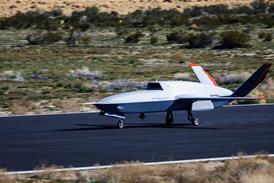BAE Systems is advancing work on a new synthetic training capability that will be employed by the UK Royal Air Force’s Eurofighter Typhoon squadrons in less than two years.
Scheduled to achieve initial operating capability in April 2021, the new system will comprise three full mission simulators and three operational mission trainers installed at RAF Coningsby in Lincolnshire, and two of each at the service’s Lossiemouth site in Scotland.

Crown Copyright
The fixed-base devices will be supported by a so-called “reference system” simulator at BAE’s Warton facility in Lancashire. Using this, software updates will be proven before being rolled out to frontline units, concurrent with modifications made to their aircraft.
Full capability will be reached around two years after the initial declaration, says Archie Neill, operational training director at BAE Systems Air, due to the time needed to replace current equipment without interrupting the delivery of training. The RAF now uses the Eurofighter programme’s ASTA infrastructure, which relies on production-standard avionics, along with UK-specific enhanced deployable cockpit trainers at both of its Typhoon bases.
BAE was in late 2017 selected by the UK Ministry of Defence as its strategic partner for the project. It has since been working with suppliers to develop the replacement system, which draws on gaming and virtual reality technology.
Once fully operational, the new equipment will support a system equally balanced between simulator-based activities and live flying, for a total of around 20 “training events” per month for each pilot. “You need to test the individual in the air sometimes… but there is better training in the synthetic environment,” Neill says. “The tactics we are using now are being observed,” he notes. “Offloading [live flying to the simulator] is not just about cost: it’s about security.”
The acquisition forms part of a wider Defence Operational Training Capability (Air) requirement, under which devices at multiple sites will be networked together. These will include Coningsby and Lossiemouth, plus RAF Waddington in Lincolnshire, and eventually RAF Marham – home to the UK’s Lockheed Martin F-35Bs.
The new training equipment will be supplied to Typhoon export customer Qatar, and Neill believes Saudi Arabia could also be a recipient if it completes a planned follow-on purchase of 48 aircraft via the UK government. Riyadh has previously acquired 72 UK-built examples.
Separately, BAE has been awarded a contract to provide the RAF with a new mission planning and debriefing system for the Typhoon – called Sceptre – to replace its current AMPA equipment.
To be delivered from November 2020, Sceptre draws on digital technology already used in support of British Army and Royal Navy operations with the Leonardo Wildcat helicopters.
BAE says Sceptre will employ 3D imaging, and show elements including “potential hazards and conflict detection, with real-time weather information [and] an intelligence picture”.
More than 30 test flights have already been performed from Warton in support of the effort, and the new equipment is also to be supplied to Qatar and Saudi Arabia.
Source: FlightGlobal.com


























